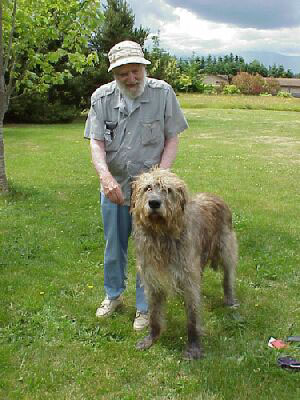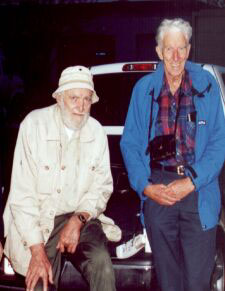
|
||||||||||||||||||
|
|
||||||||||||||||||
|
| ||||||||||||||||||
  






  









| ||||||||||||||||||
 Grover S. Krantz
Grover S. Krantz
1931 - 2002
by John W. Green
In the fall of 2000, when the Skookum cast was shown to a group of sasquatch researchers who had not been present when it was found, four out of the five newcomers were scientists with doctors' degrees. It is hard for old-timers to remember, and probably even harder for others to appreciate, how different things were 30 years before.
That is how long ago that Grover Krantz, then an associate professor of anthropology at Washington State University, risked his career, and the PhD he did not yet have, by advocating that evidence for the existence of a huge bipedal primate in North America deserved scientific study.
Then, and for years afterward, he was the only member of the academic community prepared to face the ridicule of his peers and jeopardize future prospects for tenure and promotion by insisting publicly that 'Bigfoot' tracks are made by real animals, and that the people who tell of seeing enormous, bipedal apes should be taken seriously.
His courageous example did much to stimulate participation in the study by both scientists and laymen, and for that he deserves the respect and gratitude of everyone involved, and he did a great deal more than that. While a lot of his extensive research and published work paralleled what others were also doing, he brought to it a set of skills and qualifications that no on else had. In addition some of his contributions were entirely unique.
 |
| Grover stands before his impressive collection at his home. Photo by Richard Noll. |
Grover was the first person to establish, from the study of casts and tracks, that the makers of the big footprints have a foot structure differing significantly from that of humans.
He was also the first to note and study the patterns of skin ridges that show up on a few of the casts, establishing that footprints laid down far apart in both space and time show patterns that are the same, and that differ from those of humans or any other animals.
While not the first to suggest that sasquatch might be Gigantopithecus, not extinct after all, he was the first to point out that the shape of their fossil jaws indicates that those giant apes probably walked upright. And he had the skill and knowledge to do an authoritative reconstruction, based on the largest jawbone, of a matching skull that demonstrates strikingly that Gigantopithecus was as huge as sasquatch are reported to be.
 |
| Grover enjoys time with another of his favorite animals... his Irish Wolfhound, Ralph. Photo by Richard Noll. |
He showed his courage also in enduring the abuse to which he was subjected for maintaining the increasingly unpopular opinion that it is justifiable to kill one of the animals, because nothing short of physical remains will convince science of the existence of the species. While far from being alone in that position, he was almost alone in being prepared to defend it in public.
Lost in the uproar was the fact that he spent a lot of money and effort trying to locate remains from a natural death, and also twice tried to prove himself wrong, with major attempts to obtain scientific acceptance based on the tracks, and then on the skin ridges.
It is a matter for great regret not only that he did not live to see a successful conclusion to his work but also, for the rest of us, that his work was interrupted when he still had so much more to contribute.
 |
| Grover with long-time friend and colleague John Green. Photo by Jeffrey Lemley. |
The following more detailed information is borrowed, with permission and minor alterations, from an obituary posted on the internet by another long-time researcher, Loren Coleman.
Grover S. Krantz, an anthropologist who was never afraid to take the unpopular academic position that the primates called Sasquatch actually exist, died peacefully, on the morning of February 14, 2002, in his Port Angeles, Washington home.
As the modern era's first academically-affiliated physical anthropologist to actively involve himself in Bigfoot/Sasquatch research, Dr. Krantz was one of the most quoted authorities on the status of the controversy. He began his research in 1963, and it took him from the analysis of the Patterson-Gimlin film of 1967, to an examination of the Skookum body cast of 2000.
He wrote or edited several papers on the Sasquatch, of a formal scholarly nature (published in Northwest Anthropological Research Notes) and four books, The Scientist Looks at the Sasquatch (Moscow: University Press of Idaho, 1977, with anthropologist Roderick Sprague), The Scientist Looks at the Sasquatch II (Moscow: University Press of Idaho, 1979, with Roderick Sprague), The Sasquatch and Other Unknown Hominoids (Calgary: Western Publishing, 1984, with archaeologist Vladimir Markotic) and Big Footprints (Boulder: Johnson, 1992), revised as Bigfoot Sasquatch Evidence (Seattle: Hancock House, 1999).
Dr. Krantz was the primary North American spokesperson for the stance of killing a Bigfoot to prove they exist. He will most be remembered, however, as the foremost proponent of the theory that the survival of the giant ape Gigantopithecus, thought to have become extinct during the Pleistocene, is the source of modern Sasquatch reports.
He created the first reconstructions of the full skulls of Gigantopithecus and Meganthropus, as well as restoring various elements of understudied Homo erectus finds. During the late 1990s, Dr. Krantz became one of the major supporters, in academia and in court, for the preservation for study of the disputed Kennewick skull found in Oregon which he theorized might have a non-Native American origin.
Grover Sanders Krantz, born November 5, 1931, in Salt Lake City, grew up in Rockford, Illinois, then moved with his family to Utah when he was ten. Krantz went on to study at the Universities of Utah, California, (B.A. 1955, M. A. 1958) and Minnesota (Ph. D. 1971), with a concentration in human evolution.
He was a professor at Washington State University since 1968, until his retirement in the 1990s. During his retirement he still taught one anthropology course per year, beamed via television back to Pullman, from his home in the Olympic Peninsula. He continued his research until his illness allowed him to do no more work.
Dr. Krantz was a physical anthropologist whose teaching and research had covered all aspects of human evolution, primarily of skeletal traits, but also the evolution of the human capacity for culture. He had visited many museums in Europe, China and Java to study original fossils and to make casts of some (Java) for distribution to other scientists. He had accumulated a major collection of such casts, including his own reconstructions of many of them.
Dr. Krantz's major non-Sasquatch anthropological works were Climatic Races and Descent Groups (1980), The Antiquity of Race (1981, 1994, 1998), The Process of Human Evolution (1982, 1995), and Geographical Development of European Languages (1988). Other publications included original work on such topics as Neanderthal winter survival, precision gripping of stone tools, language origins, mastoid function, tooth wear, mammal extinctions, sea-level changes, nonmigrations of hunting peoples, Neanderthal taxonomy, Ramapithecus as a female form, and pelvic evolution - all illustrated by the author.
Dr. Krantz died at his home, from pancreatic cancer. Diane Horton, his wife, was with him constantly to the end. She has sent the following e-mail message:
There will be no local service. Grover's body will be sent to the 'Body Farm' at the University of Tennessee and then his skeleton will be sent to the Smithsonian Institution along with most of his academic materials. As he helped students in life, his skeleton and materials will be available to serious scholars in death. In lieu of flowers, people can make memorial donations to Hospice of Clallam County, P.O. Box 2014, Port Angeles, WA 98362.